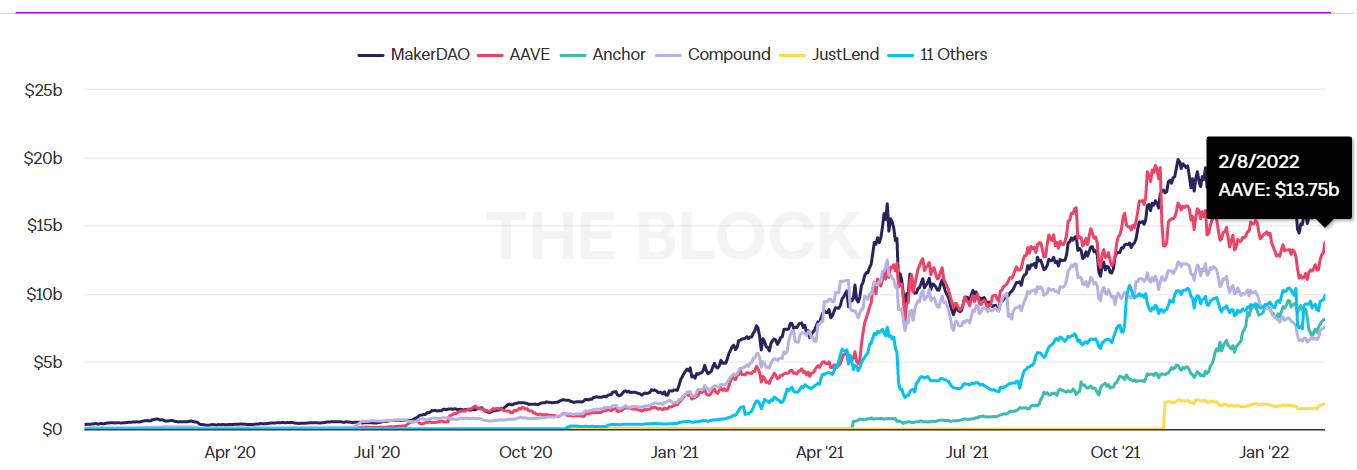For the last five years, censorship, demonetization, and deplatforming have become a perennial topic, with many criticizing the centralized nature of social media. Additionally, due to growing concerns around privacy and regulatory backlash, social media platforms are struggling to retain public confidence too.
Both legacy media and Meta (Facebook) have record low trustworthiness in recent times, with the latter barely holding at 5%.
To attempt to rectify this problem, one of the key features Web3 brings is decentralization through blockchain-based services. Lens Protocol, created by the team behind Aave, aims to be a decentralized social media platform and create a more user-oriented experience.
What Is Lens Protocol?
The way social media giants like Twitter, Meta, and Google retain their market domination is through centralized databases. Meaning, any accounts owned, either for ads or posting, are subject to a kill switch. While convenient to have centralized accounts on a few platforms, this defining Web2 characteristic has major flows:
- Your data is owned by the platform, susceptible to arbitrary shadowbanning, erasure, and economic damage.
- With the lack of ownership comes the lack of content management and portability across platforms.
Lens Protocol attempts to solve this pressing issue by developing a platform on which users can create and own pathways between their persons/businesses and the online world. In other words, Lens Protocol allows anyone to build a portable, user-owned social graph. In contrast, Web2’s online interconnectedness is governed by the companies that create the social media platforms.
A Social Media Model for Web3
In Web3, Lens Protocol places interconnectedness ownership in the hands of the people. Perhaps, the age-old question of ‘who will build the roads?‘ has finally been answered for the social media world? In brief notes, here is how Lens Protocol is poised to achieve a decentralized social graph:
- For social media to be decentralized, it needs decentralized online storage. For this reason, Lens Protocol supports the InterPlanetary File System (IPFS), a peer-to-peer network for storing and sharing files.
- This means that users can post anything they like and control how their content is engaged with.
- Through modularity, Lens Protocol can combine multiple platform features. For example, users can collect posts they like for public records (equivalent to Twitter likes). The same goes for re-sharing (Twitter’s retweeting) for content amplification.
- Likewise, users can comment and follow other people.
Because this is a blockchain-based protocol, it means all of these foundational social media elements are tokenized. Your account is a ProfileNFT, a non-custodial, permissionless, and composable smart contract. We have seen this composable approach before with wallets such as TxLink, a middleware connecting dApps with smart contracts.
4/ Lens Protocol has familiar social media functions like having a profile, commenting, resharing a post, and more – but unlike social media of the past, Lens Protocol is powered by NFTs, so you own and control all of your content. Here's how it works👇👇👇 pic.twitter.com/LqnQ8Kr37w
— LensProtocol.eth 🌿 (@LensProtocol) February 7, 2022
Adhering to the same principle, each follow made is also a FollowNFT. In conjunction, they create a permanent digital footprint on a decentralized blockchain. Furthermore, because followers are tokenized as NFTs, governance of social media engagement is built-in. Case in point, users could allow a certain number of FollowNFTs to have voting rights.
With such a system, Lens Protocol allows users to determine how their content is experienced, instead of being at the mercy of hidden centralized algorithms. To top it off, content shared is not only collectible but tradeable as well. This opens the door to micro-monetization, as each shared/mirrored content can deliver a cut to the person who shared it.

Join our Telegram group and never miss a breaking digital asset story.
Who Built Lens Protocol?
Stani Kulechov first proposed an Ethereum-based Twitter equivalent last July, in a reference to Jack Dorsey’s Bitcoin maximalism. Kulechov’s story is a common one, having ditched a career in law in favor of Ethereum.
Kulechov is the founder of Aave (AAVE) lending protocol, one of the top non-custodial liquidity mining platforms. Presently, it is just behind MakerDao, with $13.75 billion worth of cryptos locked into smart contract deposits.

Through its AAVE token, the protocol makes its profits, by getting a cut from liquidity mining. In 6 funding rounds, Aave raised $49 million. Some of its more notable investors are well-known venture capital (VC) firms such as Blockchain Capital, Standard Crypto, Three Arrows Capital, Framework Ventures, ParaFi Capital, and DTC Capital.
Presently, Lens Protocol is live on Polygon’s Mumbai testnet. Its official launch should be happening this year after successful troubleshooting is done. The question is, will Lens Protocol make a dent in the social media landscape?
It is safe to say that most people prioritize simple convenience over more involved alternatives. However, the arbitrary and oppressive nature of the current social media platforms may just be the proverbial last straw to create a critical adoption momentum.
Do you think the migration of personalities with large audiences is necessary for platforms like Lens Protocol to flourish? Let us know in the comments below.
 tokenist.com
tokenist.com